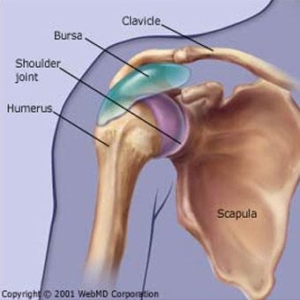What is Shoulder Bursitis?
The shoulder complex is a ball and socket joint and is comprised of several groups of muscles, three bones and several soft tissue structures including ligaments, a joint capsule, labrum and several additional soft tissue structures. One of these additional structures is a lubricating sac called a bursa. The bursa rests between the upper shoulder bone (acromion) and the rotator cuff. The bursa serves as a cushion between the musculature and boney prominences of the shoulder joint. This cushion also assists in preventing additional irritation to the rotator cuff by reducing friction.

Bursitis
Bursitis is seen in the work or athletic population that uses their arms for repetitive lifting, pushing and pulling – electricians, construction, swimming, and softball. It can also occur with normal daily activities with daily hygiene or housework. The result of this type of repetitive trauma can cause inflammation of the bursa sac causing bursitis.
Symptoms
Symptoms include tenderness throughout the shoulder complex, but primarily located in the front (anterior) and outside (lateral) portion of the shoulder. Signs of this condition can be at rest or with activity. Pain will occur with activities above the shoulder including rotational pain, feelings of tightness, weakness with extended activities above the shoulder, and difficulty reaching across the chest or behind the back.
Diagnosis
Diagnosis will be determined through a thorough history and physical examination by a trained sports medicine and orthopedic shoulder specialist. Examination will consist of palpating the shoulder complex for pain. The clinician will check both active and passive range of motion. Specific manual tests will be performed by the specialist to determine if inflammation exists, the amount of weakness and other possible factors causing symptoms. Once the initial diagnosis has been made, an X-ray of the shoulder complex will be ordered to determine if any bony conditions exist. If additional concerns are found on the exam, an MRI (3 dimensional picture) will be ordered to confirm the diagnosis and assist in determining the severity of the injury.
Treatment
Treatment goals are to maintain motion, increase strength, decrease pain and improve the functionality of the shoulder complex. Traditionally, these results are obtained through conservative management 95% of the time. A specific individualized treatment program will be created from your thorough history, physical examination, and radiological testing. Conservative management consists of a modification of activity and possibly rest, anti-inflammatory medications, a cortisone injection, orthobiologics such as PRP or Stem Cell injections and formal physical therapy. Conservative treatment, when successful will resolve signs and symptoms in 6-8 weeks. Surgical management is recommended for the patients that fail conservative management.
Shoulder Arthroscopy
Shoulder arthroscopy occurs when a small camera is placed into the shoulder joint to visualize the damage. During this visualization, ligaments, bones, and muscles of the shoulder complex are further assessed by the orthopedic surgeon. Once the assessment has been completed the surgeon uses a variety of instrumentation to decompress the area of impingement and remove the inflamed tissue. If surgical, rehabilitation and formal physical therapy will begin immediately. A physical therapist will begin your formal rehabilitation through a planned rehabilitation protocol first advancing pain-free passive range of motion and finally obtaining full strength of the shoulder complex. Total post-operative recovery from a bursectomy and decompression procedure is 6-8 weeks.
